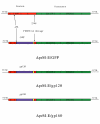Development of dengue virus replicons expressing HIV-1 gp120 and other heterologous genes: a potential future tool for dual vaccination against dengue virus and HIV
- PMID: 11747468
- PMCID: PMC61042
- DOI: 10.1186/1471-2180-1-28
Development of dengue virus replicons expressing HIV-1 gp120 and other heterologous genes: a potential future tool for dual vaccination against dengue virus and HIV
Abstract
Background: Toward the goals of providing an additional vector to add to the armamentarium available to HIV vaccinologists and of creating a bivalent vaccine effective against dengue virus and HIV, we have attempted to create vectors which express dengue virus non-structural proteins and HIV immunogens. Previously we reported the successful construction of dengue virus replicons which lack structural genes necessary for virion release and spreading infection in culture but which can replicate intracellularly and abundantly produce dengue non-structural proteins. Here we attempted to express heterologous genetic material from these replicons.
Results: We cloned into a Deltapre-M/E dengue virus replicon genes for either green fluorescent protein (GFP), HIV gp160 or HIV gp120 and tested the ability of these constructs to express dengue virus proteins as well as the heterologous proteins in tissue culture after transfection of replicon RNA.
Conclusions: Heterologous proteins were readily expressed from these constructs. GFP and gp120 demonstrated minimal or no toxicity. Gp160 expressing replicons were found to express proteins abundantly at 36 hours post transfection, but after 50 hrs of transfection, few replicon positive cells could be found despite the presence of cellular debris positive for replicon proteins. This suggested that gp160 expressed from dengue virus replicons is considerably more toxic than either GFP or gp120. The successful expression of heterologous proteins, including HIV gp120 for long periods in culture suggests this vector system may be useful as a vaccine vector, given appropriate delivery methods.
Figures









Similar articles
-
Development of Dengue virus type 2 replicons capable of prolonged expression in host cells.BMC Microbiol. 2001;1:18. doi: 10.1186/1471-2180-1-18. Epub 2001 Aug 24. BMC Microbiol. 2001. PMID: 11580862 Free PMC article.
-
Development of Dengue type-2 virus replicons expressing GFP reporter gene in study of viral RNA replication.Virus Res. 2012 Feb;163(2):552-62. doi: 10.1016/j.virusres.2011.12.007. Epub 2011 Dec 16. Virus Res. 2012. PMID: 22197424 Free PMC article.
-
Replicon-helper systems from attenuated Venezuelan equine encephalitis virus: expression of heterologous genes in vitro and immunization against heterologous pathogens in vivo.Virology. 1997 Dec 22;239(2):389-401. doi: 10.1006/viro.1997.8878. Virology. 1997. PMID: 9434729
-
Establishment and Application of Flavivirus Replicons.Adv Exp Med Biol. 2018;1062:165-173. doi: 10.1007/978-981-10-8727-1_12. Adv Exp Med Biol. 2018. PMID: 29845532 Review.
-
Viral Replicon Systems and Their Biosafety Aspects.Appl Biosaf. 2023 Jun 1;28(2):102-122. doi: 10.1089/apb.2022.0037. Epub 2023 Jun 5. Appl Biosaf. 2023. PMID: 37342518 Free PMC article. Review.
Cited by
-
Generation and preliminary characterization of vertebrate-specific replication-defective Zika virus.Virology. 2021 Jan 2;552:73-82. doi: 10.1016/j.virol.2020.09.001. Epub 2020 Oct 6. Virology. 2021. PMID: 33075709 Free PMC article.
-
Development of a novel DNA-launched dengue virus type 2 infectious clone assembled in a bacterial artificial chromosome.Virus Res. 2014 Feb 13;180:12-22. doi: 10.1016/j.virusres.2013.12.001. Epub 2013 Dec 14. Virus Res. 2014. PMID: 24342140 Free PMC article.
-
Dengue and its effects on liver.World J Clin Cases. 2015 Feb 16;3(2):125-31. doi: 10.12998/wjcc.v3.i2.125. World J Clin Cases. 2015. PMID: 25685758 Free PMC article. Review.
-
Highly efficient production of a dengue pseudoinfectious virus.Vaccine. 2014 Jun 24;32(30):3854-60. doi: 10.1016/j.vaccine.2014.03.091. Epub 2014 May 5. Vaccine. 2014. PMID: 24797700 Free PMC article.
-
Incorporation of tick-borne encephalitis virus replicons into virus-like particles by a packaging cell line.J Virol. 2003 Aug;77(16):8924-33. doi: 10.1128/jvi.77.16.8924-8933.2003. J Virol. 2003. PMID: 12885909 Free PMC article.
References
-
- Nathanson N, Mathieson BJ. Biological Considerations in the Development of a Human Immunodeficiency Virus Vaccine. Journal of Infectious Diseases. 2000;182:579–589. - PubMed
-
- Cho MW. Assessment of HIV Vaccine Development: Past, Present, and Future. Advances in Pharmacology. 2000;49:263–314. - PubMed
-
- Clerici M, Giorgi JV, Chou CC, et al. Cell-mediated immune response to human immunodeficiency virus (HIV) type 1 in seronegative homosexual men with recent sexual exposure to HIV-1. J Infect Dis. 1992;165:1012–1019. - PubMed
-
- Kaul R, Kimani J, Dong T, et al. Late seroconversion in HIV "resistant" Nairobi prostitutes is associated with a preceding decrease in HIV exposure. [abstract 489]. Program and abstracts of the 7th Conference on Retroviruses and Opportunistic Infections (San Francisco). San Francisco: Foundation for Retrovirology and Human Health, 2000. p. 168.
-
- Baba TW, Liska V, Khimani AH, Ray NB, Dailey PJ, Penninck D, Bronson R, Greene MF, McClure HM, Martin LN, Ruprecht RM. Live attenuated, multiply deleted simian immunodeficiency virus causes AIDS in infant and adult macaques. Nat Med. 1999;5:194–203. - PubMed
MeSH terms
Substances
LinkOut - more resources
Full Text Sources
Other Literature Sources

